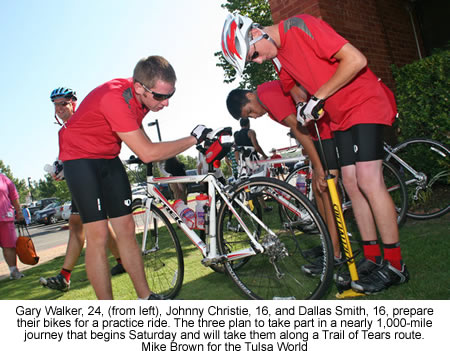 |
Canku Ota
|
 |
|
(Many Paths)
|
||
|
An Online Newsletter
Celebrating Native America
|
||
|
August 1, 2009 - Volume
7 Number 8
|
||
|
|
||
|
A Group Of Young
Cherokees Prepares To Hit The Road On A Route Of Remembrance
|
||
|
by Clifton Adcock Tulsa
(OK) World Staff Writer
|
||
|
Eight young Cherokee bicyclists will tackle a nearly 1,000-mile Remember the Removal Ride, which follows one of the Trail of Tears routes, in the searing summer heat. But it's a chance for them to see the same countryside their ancestors saw when they were forced at gunpoint to abandon everything. The riders, ranging in age from 15 to 24, will begin Saturday in Rome, Ga., near the old Cherokee capital of New Echota, following the northern Trail of Tears route through parts of Georgia, Tennessee, Kentucky, Illinois, Missouri, Arkansas and Oklahoma before ending in Tahlequah. Along the way, the cyclists will camp at night, visit and learn about historical sites intertwined with the forced march, and visit the known graves of those who could not complete the journey.
The Cherokees, who were removed from their lands about 176 years ago, experienced brutal conditions and were put into concentration camps where disease, misery and death were rampant before being forced to march through snow and ice to a land most had never seen before. The riders, who went through a rigorous selection process, have trained for about a month to make the estimated 20-day trip. Most have ridden almost daily in preparation for the average 55-mile per day ride, said Todd Enlow, a trip chaperone. "This is about teaching this group of riders about themselves as well as the history," Enlow said. "They might not have ever considered doing something like this, but when they're finished with this, they'll know what they thought was their limit they can go beyond — and dream." The route the cyclists will take stays with the northern Trail of Tears route about 95 percent of the time, Enlow said. For the only woman in the group, 20-year-old Sarah Holcomb of Vian, the ride is not only about tracing her distant ancestors' steps, but more recent ones, as well. Her mother made a similar ride in 1984. "It means a lot to be able to ride where my ancestors walked," Holcomb said. "I know it's going to be hard. I'm a very determined person. I want to be able to make it through. I'm ready to start riding." Holcomb said that, despite intimidating terrain and forecasts of terrible heat along the way, the thing she is most worried about is missing her family.
Cherokee Nation Principal Chief Chad Smith will join the riders, probably near the Nashville area, said tribal spokeswoman LeeAnn Dreadfulwater. "We're really excited," Dreadfulwater said. "It's not only a revival of the ride done (25) years ago, this is also a chance for them to go out and really discover their roots." The tribe is planning a return party for the group once they near the Tahlequah area, Dreadfulwater said. "I want to learn more about my ancestors and take the route they took," said rider Dallas Smith, 16, of Peggs. In addition, he said, "I'm looking forward to going to Nashville. I've always wanted to see Nashville." Smith's grandmother Debra Smith said she was worried about his going on the ride at first and that she and her grandson were both shaken when they heard news recently about two cyclists who were killed by a motorist near Sand Springs. Yet she remains proud of his commitment to learning more about his heritage. "He said, 'That's scary, but I'm still going,' " Smith said. "It's scary, but he's in the Lord's hands, so I'm not going to worry. It's the trip of a lifetime. I told him about his ancestry, but I can't wait for him to experience it. It will make it more real. "I'm as proud of him as I can be." The Trail of Tears
Quotes
about the removal of Cherokees “I fought through the Civil War and have seen men shot to pieces and slaughtered by thousands, but the Cherokee removal was the cruelest work I ever knew.” — Georgia militiaman who participated in the Cherokee roundup “Sir, does this government think that the people of the United States are become savage and mad? From their mind are the sentiments of love and a good nature wiped clean out? The soul of man, the justice, the mercy that is the heart’s heart in all men, from maine to Georgia, does abhor this business. ... You sir, will bring down that renowned chair in which you sit into infamy if your seal is set to this instrument of perfidy; and the name of this nation, hitherto the sweet omen of religion and liberty, will stink to the world.” — Ralph Waldo Emerson in his “Cherokee Letter” to President Martin Van Buren regarding the Treaty of New Echota |
||||||||||||||||||||||||||||||||||
|
|
||
|
|
||
| Canku Ota is a free Newsletter celebrating Native America, its traditions and accomplishments . We do not provide subscriber or visitor names to anyone. Some articles presented in Canku Ota may contain copyright material. We have received appropriate permissions for republishing any articles. Material appearing here is distributed without profit or monetary gain to those who have expressed an interest. This is in accordance with Title 17 U.S.C. Section 107. | ||
|
Canku Ota is a copyright ©
2000, 2001, 2002, 2003, 2004, 2005, 2006, 2007, 2008, 2009 of Vicki
Barry and Paul Barry.
|
||
 |
 |
|
|
The "Canku
Ota - A Newsletter Celebrating Native America" web site and
its design is the
|
||
|
Copyright ©
1999, 2000, 2001, 2002, 2003, 2004, 2005,
2006, 2007, 2008, 2009 of Paul
C. Barry.
|
||
|
All Rights Reserved.
|
||
 TAHLEQUAH
— The cyclists' path won't be easy, but it's one they are willing
to take for a chance to learn about their ancestors — and themselves.
TAHLEQUAH
— The cyclists' path won't be easy, but it's one they are willing
to take for a chance to learn about their ancestors — and themselves.
 The
Trail of Tears was the result of the forced removal of American
Indian tribes in the southeastern United States in the 1830s to
what was then Indian Territory. Although the Choctaws, Seminoles,
Creeks, Chickasaws and Cherokees all had different circumstances
surrounding their removal, some more brutal than others, thousands
of American Indians died on the way to what is now Oklahoma.
The
Trail of Tears was the result of the forced removal of American
Indian tribes in the southeastern United States in the 1830s to
what was then Indian Territory. Although the Choctaws, Seminoles,
Creeks, Chickasaws and Cherokees all had different circumstances
surrounding their removal, some more brutal than others, thousands
of American Indians died on the way to what is now Oklahoma.  "Not
being around my family, I get homesick," she said. But, "I'm
learning to do something on my own."
"Not
being around my family, I get homesick," she said. But, "I'm
learning to do something on my own."